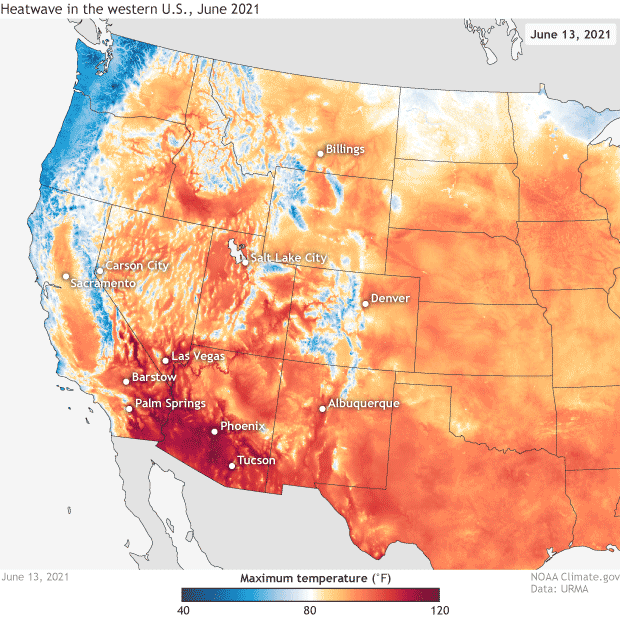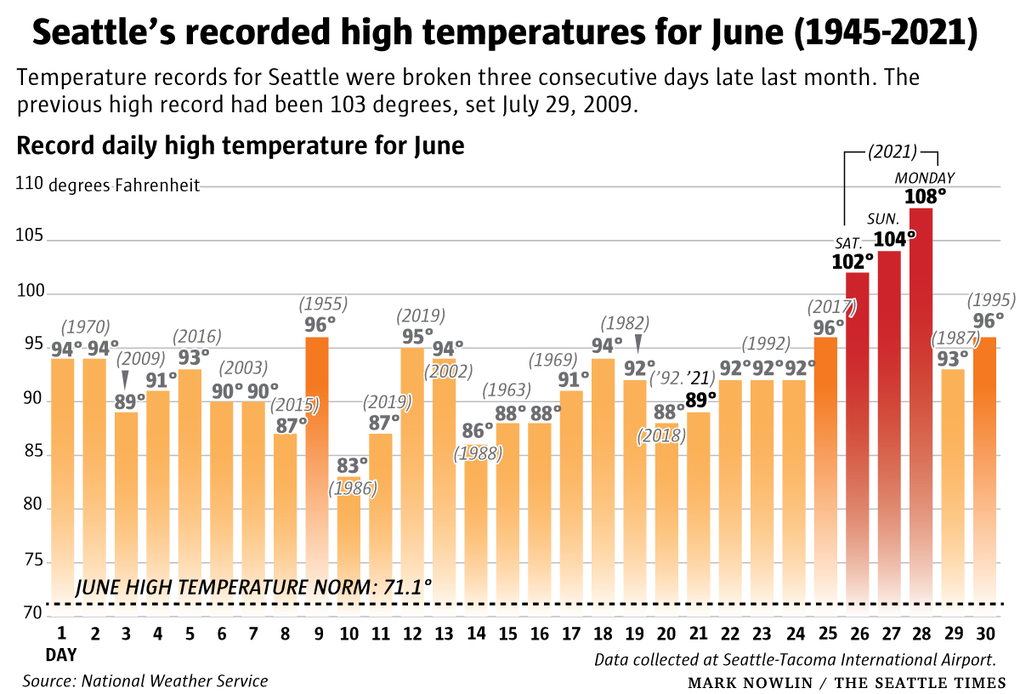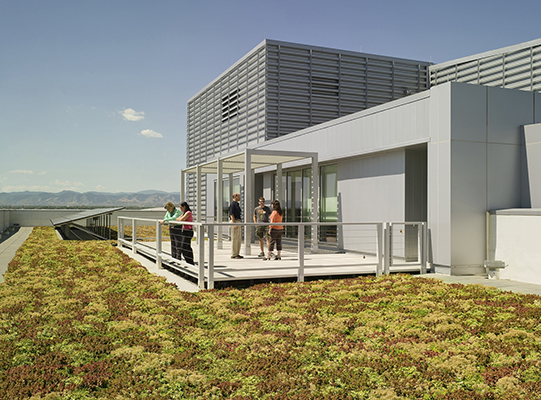What Causes Heat Waves?
A heat wave happens when there are three or more days of unusually high maximum and minimum temperatures1. Heat waves are caused by a system of high atmospheric pressure moving into a certain area2.To be considered a heat wave, temperatures have to be outside the historical average2.
2021 Heat Waves in the United states
Over the summer, the west of the United States was hit with intense heat waves. Death Valley alone hit 130oF on July 9, making it the hottest temperature anywhere in the U.S.3 This named July the single hottest month ever to be recorded, beginning 142 years ago.4 In fact, July 2021s global surface temperature was 1.67oF higher than the 20th century average of 60.40F.4 This increase in temperature is brought on by climate change.

Hot Spots in the Pacific Northwest
The Pacific Northwest is a region not known for its extreme heat but in late June this area was hit with intense heat waves. From June26-29, daytime temperatures were over 100oF, setting new records.6In Portland, Oregon, the average high temperature was 112oF while Seattle, Washington hit 108oF.6
Heat waves this far north are dangerous because these locations have less experience with such high temperatures. In the Southwest, air conditioner use is mandatory but places in the Northwest aren’t as air conditioned.6 In fact, Seattle ranked as the least air-conditioned city in the United States, with only 44% of homes having air conditioners installed.6

Heat Waves and Climate Change
Greenhouse gas emissions created by humans are largely responsible for the warming of our planet. Burning fossil fuels release these gases into the atmosphere where they trap heat near the earth’s surface.8 Carbon dioxide levels have increased by almost 50% in 250 years.8
Climate modelers are predicting that Earth will experience more severe heat waves and droughts.
Heatwave Frequency
Unfortunately, the frequency of heat waves have steadily increased since the 60s. In the past six decades, heatwaves have increased from an average of two heat waves per year to six per year.9 During the 60s, the average heat wave lasted about three days but has increased to four days in this decade.9
In the 60s, heatwave intensity was 2.0oF above the local 85th percentile but now is 2.50F above the 85th local threshold.9 If greenhouse gas emissions aren’t seriously curtailed by mid century, the warmest daily temperature is expected to increase 5oF.10
Heat Islands
When urban areas experience higher temperatures relative to outlying areas they become “islands.”11 This happens because structures such as buildings, roads, and sidewalks absorb and reemit the sun’s heat more than natural landscapes11. In the United States, urban areas are about one to seven degrees higher than rural areas during the day and about two to five degrees higher at night.11
Consequences of extreme Heat
The increase in heat waves can bring devastating consequences. They not only cause problems for the environment but also for the economy and humans.
Natural Disasters
Heat waves can increase the occurrences of natural disasters. Drought conditions become more likely and storm intensity and wind speeds increase.12 Not only do higher temperatures cause a rise in droughts, they also lead to increased risk of wildfires. In the middle of June, wildfires sprung up in California, Arizona, Colorado, Utah, and Montana.12
Humans
Extreme heat kills around 1,300 people in the United States a year.13 This is because of heat stress- a condition that happens when the body is unable to cool itself effectively.5 When sweat can’t evaporate properly, it leads to heatstroke. Small children, the elderly, people with chronic disease, and outdoor workers have higher heat-related risk14.
Economic
The toll heat waves have on the economy can be steep. Heatwaves often result in power outages and blackouts. This costs the United states economy roughly $150 billion annually.15
Heatwaves are also associated with strained food security. In agriculture, farmers are only able to yield about half of their usual crop because the intense heat makes them too soft to harvest.16 Livestock also suffer. Cattle are experiencing decline in milk production, growth rates, and conception rates.
In addition, heat waves force outdoor workers inside, causing a decline in income. It has been projected that 2% of total working hours will be lost every year to intense heat.17
Cooling Strategies
The effects of heat waves have wreaked havoc on this planet. Fortunately, conservationists and scientists have been finding new ways to dampen the effects of heat waves and lessen their intensity.
Trees and Vegetation
Trees and vegetation lower surface temperatures by providing shade and through evapotranspiration. Surface temperatures for shaded areas can be 20-45oF cooler than unshaded areas.11
Adding trees and other vegetation reduces energy use because they decrease the demand for air conditioning.11 They also remove air pollutants and decrease the production of greenhouse gas emissions by storing carbon dioxide.11
Green Roofs
Green roofs are roofs that have a vegetative layer growing on top. They provide shade, remove heat from the air, and lower roof temperatures.11 Green roof temperatures can be 30-40oF lower than conventional roofs.11

Cool Roofs
Cool roofs help reflect sunlight and heat away from a building. A high solar reflectance and high thermal emittance is needed and helps roofs to stay 50-60oF cooler than conventional roofs.11

How To Stay Safe During Heat waves
Watch for Notifications from the National weather Service
This service issues warnings when long periods of heat are expected. You should also learn the terms associated with heat waves18:
- Excessive heat outlook- potential heatwave in 3-7 days
- Excessive heat watch- favorable conditions in 24-72 hours; occurrence and time still uncertain
- Excessive heat warning/advisory- 12 hours before onset; take precautions immediately
Stay Hydrated
Drink a lot of water. The average person needs about ¾ of a gallon of water daily!19 Also, stay away from sugary, caffeinated, and alcoholic drinks.19
Gather Emergencies Supplies
Of course, a lot of stores ended up closing in the 2021 heatwaves, so make sure to stock up on food, water, and medications.18 Also, make sure you keep foods with high water contents around such as fruits and veggies.19 Keep flashlights and extra batteries on hand.
Keep Your Home Cool
Cover your windows with drapes or shades.18 Have a window air conditioner installed.18
Find a Cool Place to Go
If your home isn’t insulated or has no air conditioning, try to stay with someone who does, such as a neighbor or family member.18 Look for public places that could still be open, such as the library.18
Stay Indoors
Try limiting outdoor activity to morning and evening hours when it’s coolest. Make sure to wear sunscreen that says “broad spectrum” or “UVA/UVB protection.18
Wear Appropriate Clothing
Keep cool by wearing light-weight, light-colored, and loose fitting clothes. If you have to go out, use hats and sunglasses.18
Consider Your Pets
Never leave pets inside a hot car. Keep pets indoors with plenty of water.19
Use the Stove Less Often
Try to stick to foods that don’t have to be cooked or warmed up. If you do have to use your oven, think about how long you need to preheat it. Also, do any prep work before you cut the oven on.20
Sources
1. “What is a Heatwave?” SA Health, https://www.sahealth.sa.gov.au/wps/wcm/connect/public+content/sa+health+internet/healthy+living/protecting+your+health/environmental+health/healthy+in+the+heat/what+is+a+heatwave
2.McLeod, Jaime. “What causes a Heat Wave?” Farmer’s Almanac, 23 August 2021, https://www.farmersalmanac.com/what-causes-a-heat-wave-10912
3.Masters,Jeff. “Death Valley, California, Breaks the All-Time World Heat Record for the Second Year in a Row. Yale Climate Connections, 12 July 2021, https://yaleclimateconnections.org/2021/07/death-valley-california-breaks-the-all-time-world-heat-record-for-the-second-year-in-a-row/
4.Lindsay,Rebecca. “Earth’s Hottest Month Was Record Hot in 2021.” NOAA Climate,16 August 2021, climate.gov/news-features/understanding-climate/earths-hottest-month-was-record-hot-2021
5.Di Liberto, Tom. “Record-breaking June 2021 heatwave impacts the U.S. West.” NOAA Climate, 23 June 2021, https://www.climate.gov/news-features/event-tracker/record-breaking-june-2021-heatwave-impacts-us-west
6.Di Liberto, Tom. “Astounding heat obliterates all-time records across the Pacific Northwest and Western Canada in June 2021.” NOAA Climate, 30 June 2021, https://www.climate.gov/news-features/event-tracker/astounding-heat-obliterates-all-time-records-across-pacific-northwest
7. “Seattle already set a record high temperature Sunday; Monday’s forecast is ‘unheard of’.” Seattle Times, 27 June 2021, https://www.seattletimes.com/seattle-news/weather/seattle-already-set-record-high-temperatures-sunday-mondays-forecast-is-unheard-of/
8. Bates, Sofie. “The Climate Events of 2020 Show How Excess Heat is Expressed on Earth.” NASA, 14 Jan 2021, https://www.nasa.gov/feature/goddard/2021/the-climate-events-of-2020-show-how-excess-heat-is-expressed-on-earth
9.”Climate Change Indicators: Heat Waves.” Environmental Protection Agency, epa.gov/climate-indicators/climate-change-indicators-heat-waves
10.”Heat Waves and Climate Change.” Center for Climate and Energy Solutions, c2es.org/content/heat-waves-and-climate-change/
11.”Heat Island Effect.” Environmental Protection Agency, https://www.epa.gov/heatislands
12.”How Can Climate Change Affect Natural Disasters?” U.S geological Survey, usgs.gov/faqs/how-can-climate-change-affect-natural-disasters
13.”Climate Change Indicators: Heat-Related Deaths.” Environmental Protection Agency, epa.gov/climate-indicators/climate-change-indicators-heat-related-deaths
14.”Keep Your Cool in Hot weather!.” Center for Disease Control, cdc.gov/nceh/features/extremeheat/index.html
15.”A Day Without Power: Outage Costs For Businesses.” Bloom Energy, bloomenergy.com/blog/a-day-without-power-outage-costs-for-businesses/
16.Rosenberg,Lizzy. “The Heat Wave is Frying Your Fruits, Vegetables, Grains, and Wine.” Green Matters, 12 July 2021, greenmatters.com/p/how-does-heat-wave-affect-crops
17.“Heat Waves.” Future Earth, futureearth.org/publications/issue-briefs-2/heatwaves/
18.”Heat Wave Safety.” American Red Cross, https://www.redcross.org/get-help/how-to-prepare-for-emergencies/types-of-emergencies/heat-wave-safety.html
19. The Editors. “Heat Waves: 10 Tips for Extreme Heat Safety.” The Old Farmer’s Almanac, 29 June 2021, https://www.almanac.com/heat-waves-10-tips-extreme-heat-safety
20.Farrell, Mary H.J. “Cooking Tips for Hot Weather: How to Keep Your Cool in the Kitchen This Summer.” Consumer Reports, 9 July 2021, https://www.consumerreports.org/cooking-baking/cooking-tips-for-hot-weather-a8288264150/








